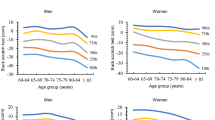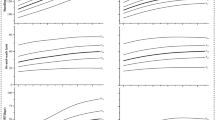Abstract
The objective of this study was to find the optimal age in dividing the group in Taiwan. It used the 9660 health-related fitness data, in ages ranging from 25 to 49 years, including nine measurement indexes using systolic pressure, diastolic pressure, static heart rate, body height, body weight, 30-s sit-ups, 60-s sit-ups, sitting trunk flexion (sit and reach), and 3-min step test. This study was to find out the optimal age group by utilizing hierarchical clustering analysis and one-way ANOVA. The results show that the best way to divide male groups was by adopting the age ranges of 25–28 years, 29–32 years, 33–37 years, 38–46 years, and 47–49 years to groups 1–5, respectively. The female groups 1–5 was 25–28 years, 29–35 years, 36–41 years, 42–45 years, and 46–49 years, respectively.









Similar content being viewed by others
References
American College of Sports Medicine (2013) ACSM’s resource manual for guidelines for exercise testing and prescription, 7th edn. Lippincott Williams & Wilkins, New York
Aoyagi Y, Shephard RJ (1992) Aging and muscle function. Int J Sports Med 14:376–396
Banks DA, Fossel M (1997) Telomeres, cancer, and aging. Altering the human life span. JAMA 278(16):1345–1348
Botz WM (1996) How fast do we age? Exercise performance over time as a biomarker. J Gerontol 51A(5):223–225
Chang JB (1993) Application of multivariate analysis. Wenfu Book, Taipei
Clark AP, Baldwin K (2004) Best practices for care of older adults: highlights and summary from the preconference: NACNS National Conference, March 10, 2004, San Antonio, Tex. Clin Nurse Spec 18(6):288–299
Janssen I, Heymsfield SB, Wang ZM, Ross R (2000) Skeletal muscle mass and distribution in 468 men and women aged 18 ± 88 yr. J Appl Physiol 89:81–88
Kyle UG, Gremion G, Genton L, Slosman DO, Golay A, Pichard C (2001) Physical activity and fat-free and fat mass as measured by bioelectrical impedance in 3853 adults. Med Sci Sports Exerc 33:576–584
Lin QS (1992) Psychology and education statistics. Donghua Book. Taipei
Lowrey GH (1978) Growth and development of children. Year Book, Chicago
McArdle WD, Katch FI, Katch VL (1991) Exercise physiology: energy, nutrition, and human performance. Lea & Febiger, Michigan
Pyron MI (2002) The aging athlete: risks and benefits of exercise. Curr Opin Orthop 13:128–133
Peng ZY (2001) SAS and statistical analysis. Rulin Books Co., Ltd, Taipei
Timiras PS (1972) Developmental physiology and aging. Macmillan, New York
Wang W et al (1991) Human development studies. Hua Xing Publishing House, Taipei
Wenger NK, Speroff L, Packard B (1993) Cardiovascular health and disease in women. N Engl J Med 329(4):247–256
Zhong YR, Huang WJ (2002) Exercise physiology of the elderly. TAPAS J 1(1):12–13
Author information
Authors and Affiliations
Corresponding author
Ethics declarations
Conflict of interest
The authors declare that they have no conflict of interest.
Ethical approval
All procedures performed in studies involving human participants were in accordance with the ethical standards of the institutional and national research committee and with the 1964 Helsinki declaration and its later amendments or comparable ethical standards.
Informed consent
Written informed consent was obtained from all individual participants included in the original study.
Additional information
Publisher's Note
Springer Nature remains neutral with regard to jurisdictional claims in published maps and institutional affiliations.
Rights and permissions
About this article
Cite this article
Hsu, Py., Kuo, Yt. A study of dividing the group by age of health-related fitness in Taiwan. Sport Sci Health 16, 147–158 (2020). https://doi.org/10.1007/s11332-019-00591-9
Received:
Accepted:
Published:
Issue Date:
DOI: https://doi.org/10.1007/s11332-019-00591-9




